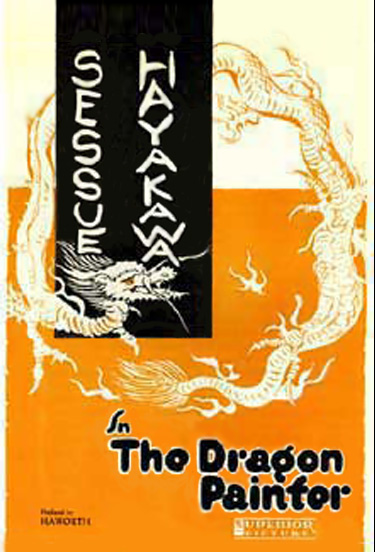
The Dragon Painter
by Lu Chen
The Dragon Painter (1919), Dir: William Worthington, Milestone Film and Video
 Scene from The Dragon Painter
Once upon a time there was a master of dragon painting whose dragons
were vivid in all senses but without eyes. Once, upon repeated pleas of a
viewer, he added eyes to a dragon, and the dragon suddenly came to
life, flew out of the picture, disappeared.
Like this Chinese proverb, The Dragon Painter centers on the
painting and unpainting of a dragon. Produced by, and starring, the
Japanese-born actor Sessue Hayakawa, the film transplants an oriental
tale onto the western screen, with a twist.
Scene from The Dragon Painter
Once upon a time there was a master of dragon painting whose dragons
were vivid in all senses but without eyes. Once, upon repeated pleas of a
viewer, he added eyes to a dragon, and the dragon suddenly came to
life, flew out of the picture, disappeared.
Like this Chinese proverb, The Dragon Painter centers on the
painting and unpainting of a dragon. Produced by, and starring, the
Japanese-born actor Sessue Hayakawa, the film transplants an oriental
tale onto the western screen, with a twist.
Tatsu, the inspired but tormented artist, never paints the dragon directly. Instead, he follows traditional Asian aesthetics to paint the spirit, rather than the shape, and leaves blank space for the unspoken meaning. The repeated vistas of natural scenery—shot in Yosemite—evoke the meaningful lightness of Tatsu’s empty landscape paintings. The traveling shots adopt no character’s point of view, just as the best known Haiku, roughly translated as “old pond/a frog jumps/the sound of water,” assumes no human watching or reacting to the scene. Tatsu, the artist, has united his being with the spirit of nature in impassioned but tranquil self-forgetfulness. The dragon, associated with water, fluidity, and infinite changes, is a perfect symbol for his lost princess—the “spiritual rhythm” of his art defying direct presentation. When, later in the film, the reincarnated princess appears in Tatsu’s dream, we see not a western cinematic dreamscape, but a scene in Noh drama, where a transcendental being from the other world visits the deuteragonist in his dream. Tastu serves as the medium for us to glimpse the higher truth of the beyond.
The film, however, leads Tatsu to find his princess incarnated and to paint her portrait, and the morning after the dream Tatsu would return to his role in a western drama. We see through his eyes the hallucinated princess, framed by the window just as she is first presented to him from behind a traditional paper screen. In both cases, Tatsu is also under the gaze of his master. This supposed fable of aesthetics becomes a story of conspiracy and betrayal.
Indeed, conspiracy and betrayal are familiar themes to Hayakawa, the first Asian actor to achieve stardom in Hollywood. In Typhoon (1914) and The Cheat (1915), he played the popular role of the diabolic Oriental, whose lecherous cunning contrasts the sweet innocence of the white women fallen into his hands. The Dragon Painter subverts racial stereotyping by casting the Caucasian Edward Peil, Sr. as the master painter and artistic father of Tatsu, and leaves the audience to savor the irony when Tatsu presents his final work—a western-styled figure painting with him and his princess chasing a real dragon. His princess summarizes the moral of the story: “Love is the servant of Art”—a classic western theme.
 Scene from The Dragon Painter
Scene from The Dragon PainterTatsu, the inspired but tormented artist, never paints the dragon directly. Instead, he follows traditional Asian aesthetics to paint the spirit, rather than the shape, and leaves blank space for the unspoken meaning. The repeated vistas of natural scenery—shot in Yosemite—evoke the meaningful lightness of Tatsu’s empty landscape paintings. The traveling shots adopt no character’s point of view, just as the best known Haiku, roughly translated as “old pond/a frog jumps/the sound of water,” assumes no human watching or reacting to the scene. Tatsu, the artist, has united his being with the spirit of nature in impassioned but tranquil self-forgetfulness. The dragon, associated with water, fluidity, and infinite changes, is a perfect symbol for his lost princess—the “spiritual rhythm” of his art defying direct presentation. When, later in the film, the reincarnated princess appears in Tatsu’s dream, we see not a western cinematic dreamscape, but a scene in Noh drama, where a transcendental being from the other world visits the deuteragonist in his dream. Tastu serves as the medium for us to glimpse the higher truth of the beyond.
The film, however, leads Tatsu to find his princess incarnated and to paint her portrait, and the morning after the dream Tatsu would return to his role in a western drama. We see through his eyes the hallucinated princess, framed by the window just as she is first presented to him from behind a traditional paper screen. In both cases, Tatsu is also under the gaze of his master. This supposed fable of aesthetics becomes a story of conspiracy and betrayal.
Indeed, conspiracy and betrayal are familiar themes to Hayakawa, the first Asian actor to achieve stardom in Hollywood. In Typhoon (1914) and The Cheat (1915), he played the popular role of the diabolic Oriental, whose lecherous cunning contrasts the sweet innocence of the white women fallen into his hands. The Dragon Painter subverts racial stereotyping by casting the Caucasian Edward Peil, Sr. as the master painter and artistic father of Tatsu, and leaves the audience to savor the irony when Tatsu presents his final work—a western-styled figure painting with him and his princess chasing a real dragon. His princess summarizes the moral of the story: “Love is the servant of Art”—a classic western theme.

No comments:
Post a Comment